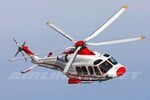MIflyer
1st Lieutenant
From Air Force Magazine:
The Air Force will receive its first MH-139 helicopter for testing in December, as it enters the next phase of the $2.4 billion effort to replace the Vietnam-era UH-1N Hueys, the head of Air Force Global Strike Command said Sept. 18.
Boeing and Leonardo are teaming up to provide the MH-139s, a new military variant of a civilian helicopter the Air Force chose one year ago. The fleet of up to 84 airframes will replace Bell-made UH-1 Hueys at nuclear missile fields across the US and for other transport and VIP missions. After years of trying to get a helicopter on contract, the Air Force required that Boeing deliver the first two aircraft by the end of 2019.
"We have a very good helicopter, and everything is on track," AFGSC Commander Gen. Tim Ray told reporters at
AFA's Air, Space & Cyber Conference. "I'm knocking on wood, but I'm very pleased to see that we're getting ready to have the first aircraft for test delivered here in December."
He added that airmen expect to receive operational helicopters in fiscal 2021. In fall 2018, the Air Force said it planned to accept ready helos through fiscal 2027.

The Air Force will receive its first MH-139 helicopter for testing in December, as it enters the next phase of the $2.4 billion effort to replace the Vietnam-era UH-1N Hueys, the head of Air Force Global Strike Command said Sept. 18.
Boeing and Leonardo are teaming up to provide the MH-139s, a new military variant of a civilian helicopter the Air Force chose one year ago. The fleet of up to 84 airframes will replace Bell-made UH-1 Hueys at nuclear missile fields across the US and for other transport and VIP missions. After years of trying to get a helicopter on contract, the Air Force required that Boeing deliver the first two aircraft by the end of 2019.
"We have a very good helicopter, and everything is on track," AFGSC Commander Gen. Tim Ray told reporters at
AFA's Air, Space & Cyber Conference. "I'm knocking on wood, but I'm very pleased to see that we're getting ready to have the first aircraft for test delivered here in December."
He added that airmen expect to receive operational helicopters in fiscal 2021. In fall 2018, the Air Force said it planned to accept ready helos through fiscal 2027.





